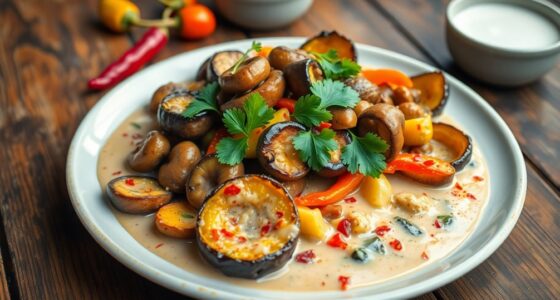Pork tenderloin with prunes and pine nuts on an onion pillow is a delicious blend of sweet and savory flavors. You'll start by stuffing the tenderloin with a mixture of soaked prunes, sautéed shallots, and toasted pine nuts. The pork roasts atop caramelized onions, adding moisture and depth. Aim for an internal temperature of 145°F for juicy results. This dish is perfect for impressing guests and celebrating culinary traditions, and there's plenty more to discover about it!
History
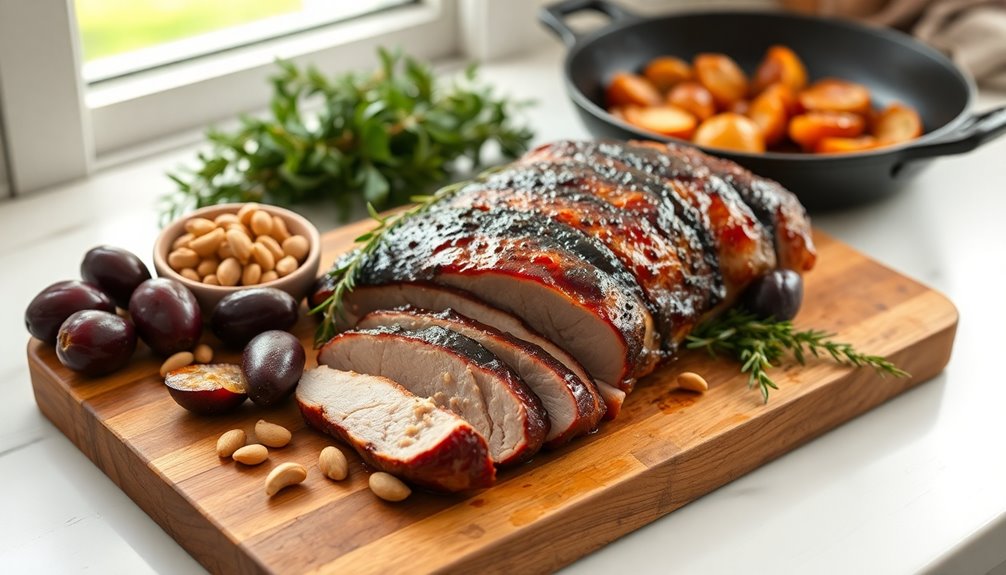
When you delve into the history of pork tenderloin, you'll find that its combination with prunes and pine nuts reflects a rich culinary tapestry woven from both French and Latin American traditions.
The French dish Porc aux pruneaux showcases how dried fruits enhance savory flavors, often slow-cooked in white wine for tenderness. Similarly, in Ecuador, holiday celebrations feature similar pork recipes, highlighting local ingredients.
Stuffed pork tenderloin with prunes and nuts harks back to medieval cooking, where sweet and savory blends were cherished. This dish illustrates the evolution of cooking techniques over time, merging diverse cultural influences into a contemporary comfort food.
The interplay of flavors makes it a cherished choice for special occasions, celebrating a delightful history that continues to inspire. Additionally, the use of butter's role in enhancing flavors and textures in cooking reflects its historical significance in culinary traditions.
Recipe
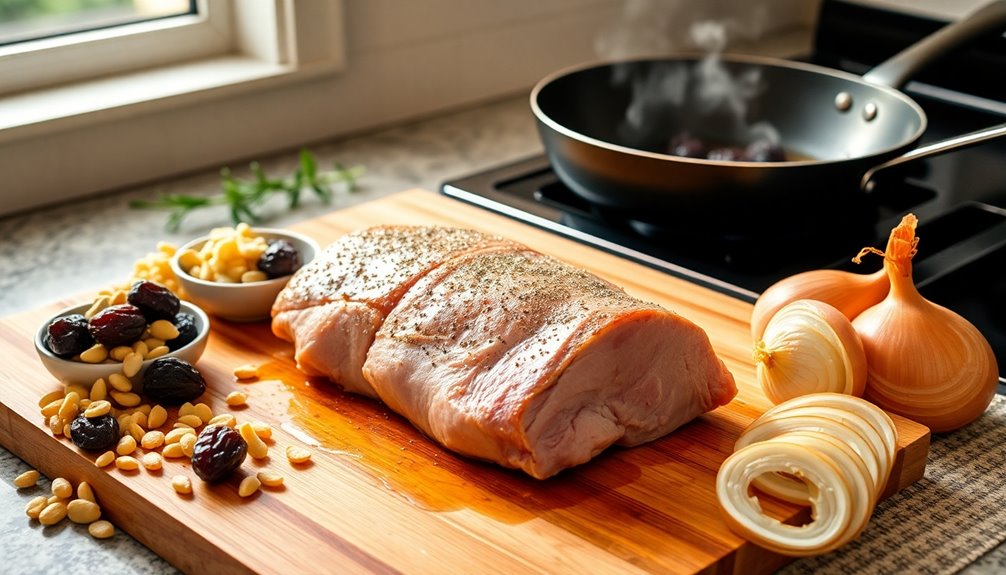
To ensure your pork tenderloin is perfectly cooked, it's essential to monitor the internal temperature closely. Roasting at 425°F for approximately 30 minutes will yield tender and juicy pork when cooked to an internal temperature of 145°F.
Pairing this dish with quick-cooking vegetables and finishing with a puree made from the pan juices elevates the dining experience, making it an impressive meal for any occasion. A light and healthy alternative, like a salad, can complement the richness of the pork.
Ingredients:
- 1 pork tenderloin
- 1 cup prunes
- 1/2 cup pine nuts
- 2 shallots, finely chopped
- 1 cup white wine
- 2 tablespoons olive oil
- Salt and pepper to taste
- 2 large onions, sliced
- Optional: quick-cooking vegetables of your choice
Cooking Instructions:
Begin by soaking the prunes in white wine for about 30 minutes to enhance their flavor.
In a skillet, heat 1 tablespoon of olive oil and sauté the chopped shallots until translucent. Add the soaked prunes and pine nuts to the skillet, mixing well and seasoning with salt and pepper.
Preheat your oven to 425°F. Carefully cut a pocket into the pork tenderloin and stuff it with the prune and pine nut mixture.
In an oven-safe skillet, heat the remaining olive oil and sear the pork on all sides until browned. Remove the pork and sauté the sliced onions until caramelized, then place the pork on top of the onions.
Roast in the oven for about 30 minutes, or until the internal temperature reaches 145°F. Let the pork rest for a few minutes before slicing and serving atop the onion pillow, drizzled with pan juices.
Extra Tips:
For an added layer of flavor, consider marinating the pork tenderloin in the white wine for a few hours before cooking. This will infuse the meat with the wine's complexity.
Be sure to use a meat thermometer to avoid overcooking the pork, which can lead to dryness.
When serving, don't forget to drizzle the pan juices over the sliced tenderloin for a beautiful finish. Pairing with a fresh, light salad can also balance the richness of the dish, making for a well-rounded meal.
Cooking Steps
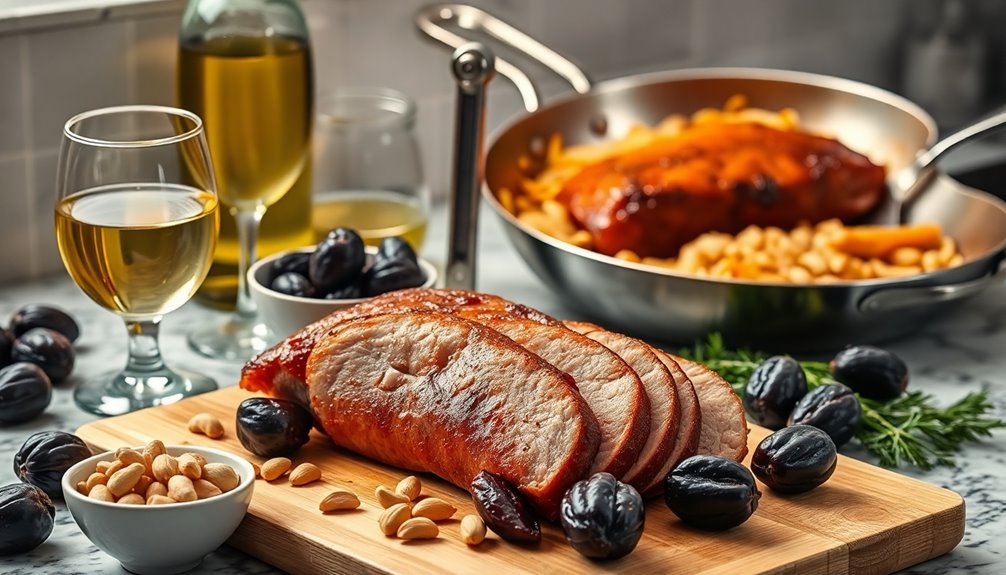
Now that you've got the ingredients ready, it's time to get cooking!
Start by preparing and searing the pork tenderloin to lock in those flavors.
Then, stuff it with the delicious prune mixture and bake until it's golden brown and irresistible. Additionally, consider using butter's composition to enhance the richness of your dish, as the fat content helps to create a luscious texture.
Step 1. Prepare the Pork Tenderloin
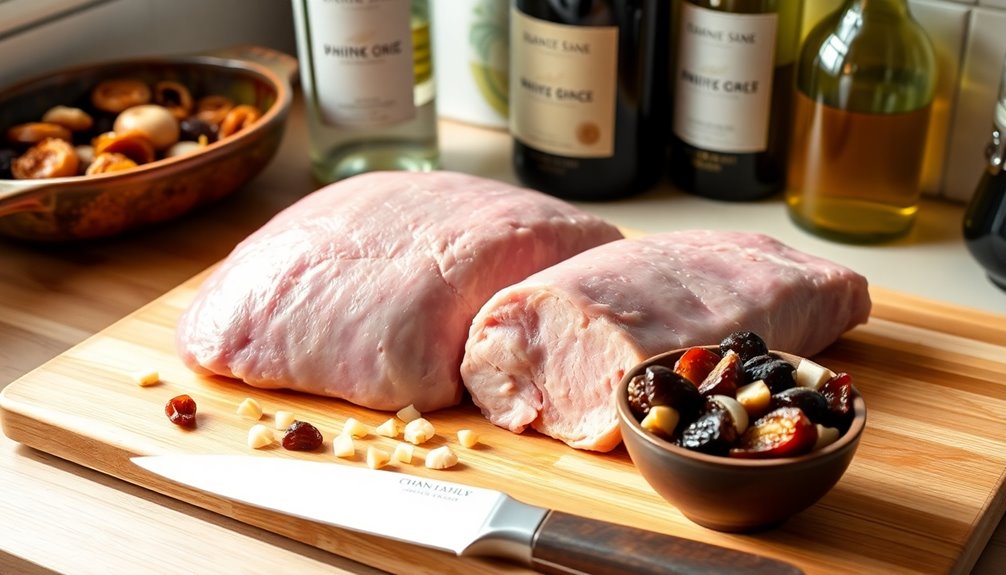
Before diving into the cooking process, start by soaking 8 oz of unpitted prunes in white wine or Cognac for 1-2 hours; this step enhances their flavor and prepares them for the stuffing.
While the prunes soak, sauté four large chopped onions in butter with thyme for about 15 minutes until fragrant. Add balsamic vinegar for extra depth.
Next, cut the pork tenderloin in half lengthwise to create a pocket, leaving one end connected. Fill this pocket with a mixture of sautéed onions, half of the soaked prunes, and toasted pine nuts. Securely tie the tenderloin with kitchen string.
Roast the stuffed pork in a preheated oven at 425°F until the internal temperature reaches 145°F, ensuring it stays juicy and tender. Additionally, pairing this dish with a cup of herbal teas may promote relaxation and enhance the dining experience.
Step 2. Sear Pork Tenderloin on Skillet

With the pork tenderloin prepared and stuffed, the next step is to sear it on the skillet.
Begin by heating a pan over medium-high heat and adding a tablespoon of oil to prevent sticking. Generously season the pork tenderloin with salt and pepper, enhancing its flavor.
Once the skillet is hot, place the pork in the pan and sear it for about 3-4 minutes on each side, creating a golden-brown crust that locks in moisture.
Don't forget to use tongs to hold the tenderloin upright, searing the ends for an additional 1-2 minutes for even cooking.
Once seared, transfer the pork to the oven to finish cooking, aiming for an internal temperature of 145°F (63°C) for optimal doneness. Additionally, achieving the right color accuracy is essential for presentation, as vibrant colors enhance the overall visual appeal of the dish.
Step 3. Stuff With Prune Mixture
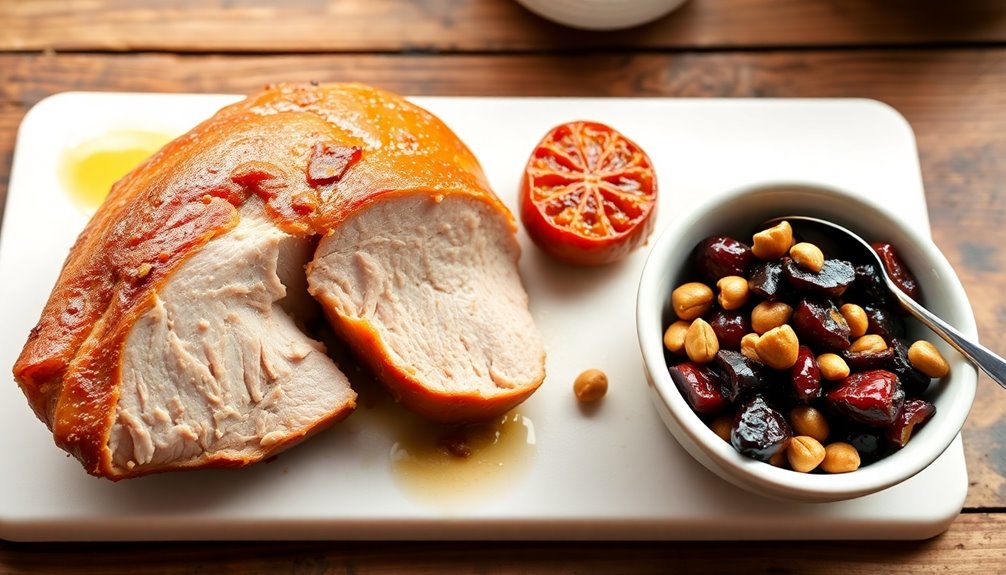
Start by soaking 8 oz of dried prunes in Cognac or Armagnac for 1-2 hours to enhance their flavor.
While the prunes soak, sauté four large chopped onions in butter with thyme for about 15 minutes until fragrant.
Deglaze the pan with balsamic vinegar to add depth to the stuffing.
Next, combine half of the soaked prunes with the sautéed onions and 3 oz of toasted pine nuts to create a rich prune mixture.
Cut the pork tenderloin in half lengthwise and fill it with the stuffing.
Roll the tenderloins tightly and secure them with kitchen string.
Don't forget to season the outside with salt and black pepper, then let it rest at room temperature for one hour before roasting. Incorporating health benefits of cacao into your meals can enhance the overall flavor and nutritional profile.
Step 4. Bake Until Golden Brown
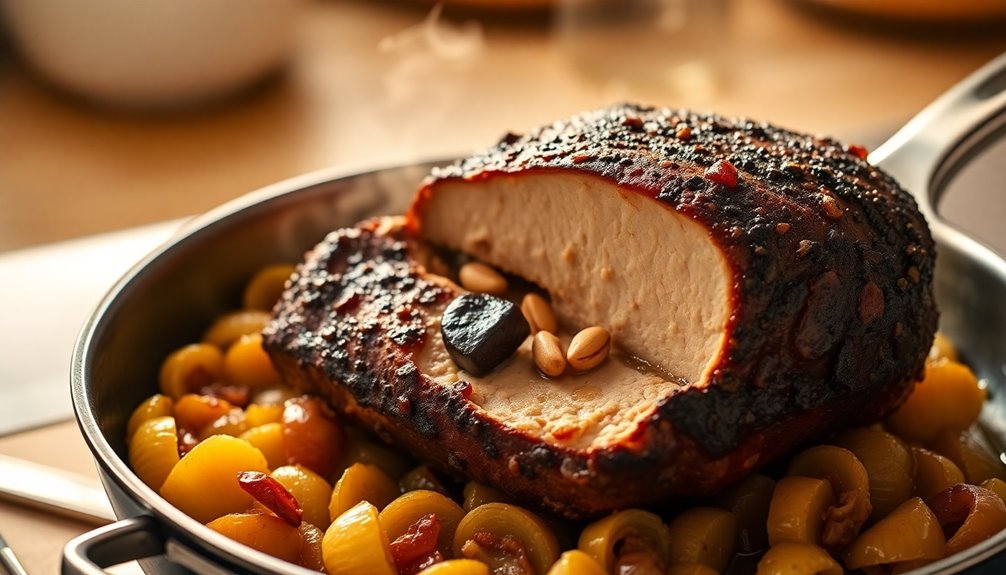
As you preheat the oven to 425°F (220°C), ensure your pork tenderloin is ready for the next steps.
Start by searing the stuffed pork in a hot pan for 6-7 minutes on each side, developing a rich brown crust.
Once seared, transfer the tenderloin to the oven and bake until golden brown, which should take about 30 minutes.
Keep an eye on the internal temperature; you want it to reach 145°F (63°C) to ensure it stays juicy and flavorful.
For an extra touch, consider broiling the tenderloin for 3-5 minutes at the end to enhance that golden color and create a crispy top.
This process will ensure a deliciously tender pork ready for serving. Additionally, by tracking your income and expenses, you can better allocate funds for quality ingredients and enhance your cooking experience.
Step 5. Rest for 10 Minutes
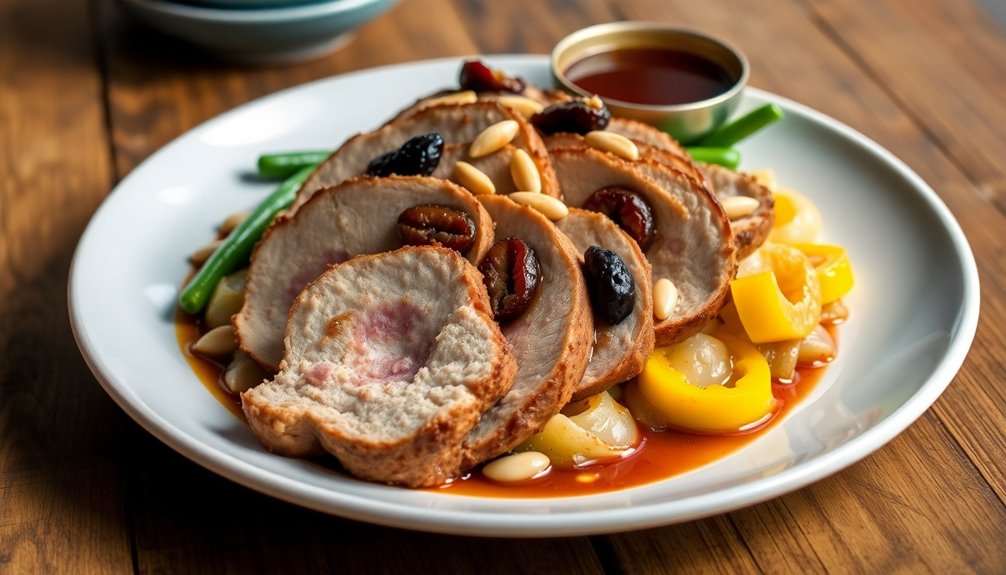
Letting your pork tenderloin rest for 10 minutes after cooking is essential for a juicy and flavorful dish. During this resting period, the meat redistributes its juices, ensuring every slice is moist.
If you slice the pork too soon, those precious juices will flow out, leaving you with a drier texture. Cover the pork loosely with foil to keep it warm while preventing steam from affecting the texture.
You'll also notice the internal temperature may rise slightly, reaching the recommended doneness of 145°F (63°C). This time allows the flavors from the stuffing—like prunes and pine nuts—to meld, enhancing the overall taste. Additionally, properly resting meat can be compared to the importance of personal and community resilience in emergency situations, as both require a thoughtful approach to yield the best results.
Trust the process; resting the meat is key to achieving that flavorful final dish.
Final Thoughts

While you may think that preparing an elegant dish like pork tenderloin with prunes and pine nuts is daunting, it's actually quite achievable and rewarding.
This flavorful dish beautifully balances the sweetness of prunes with the savory notes of pork. Stuffing the tenderloin with sautéed shallots, soaked prunes, and pine nuts enhances its richness and texture, while cooking it on a bed of onions keeps the meat moist and adds depth.
Aim for an internal temperature of 145°F (63°C) to ensure perfect doneness. This dish not only showcases your culinary skills but also makes a stunning presentation for dinner parties and festive occasions. Exploring global flavors can further enhance your cooking repertoire.
You'll impress your guests while enjoying a delicious and satisfying meal.
Frequently Asked Questions
Is It Better to Cook Pork Tenderloin Covered or Uncovered?
When you cook pork tenderloin, it's generally better to do so uncovered.
This method helps achieve a crispy exterior while keeping the inside tender and juicy. Cooking uncovered allows for browning and caramelization, enhancing the flavor.
If you cover it, you might end up steaming the meat, which can prevent that desirable crust.
For the best results, start uncovered and then cover it later to retain moisture without sacrificing texture.
Is It Better to Cook a Pork Tenderloin at 350 or 400?
Cooking pork tenderloin at 400°F can cut your cooking time by nearly 10 minutes compared to 350°F.
If you want a quick meal with a beautifully seared exterior, go for the higher temperature—it takes about 20-25 minutes.
However, if you prefer a more tender result and don't mind waiting a bit longer, 350°F is your friend, taking about 25-30 minutes.
Always check the internal temperature to ensure safety and juiciness!
What Cooking Method Is Best for Pork Tenderloin?
The best cooking method for pork tenderloin is roasting. This technique ensures even cooking and helps retain moisture, resulting in a tender outcome.
Before roasting, you should sear the tenderloin; it enhances the flavor and creates a nice crust. Aim for an internal temperature of 145°F (63°C), using a meat thermometer to avoid overcooking.
For extra flavor, consider marinating the pork overnight; it adds delicious depth to your dish.
Is It Better to Sear Pork Tenderloin Before Baking?
Yes, it's better to sear pork tenderloin before baking.
When you sear the meat, you develop a rich, caramelized crust that adds depth to the flavor. This process also locks in the juices, keeping the pork tender and moist during baking.
Searing for just 2-3 minutes on each side in a hot pan creates a beautiful contrast between the crispy exterior and the juicy interior, making your dish visually appealing and delicious.
Conclusion
You've savored the rich history, you've relished the delightful recipe, and you've embraced the cooking steps. Now, as you plate your pork tenderloin with prunes and pine nuts, you celebrate the flavors, you admire the presentation, and you anticipate the joy of sharing this dish. Each bite brings warmth, each texture offers surprise, and each aroma invites conversation. So gather your loved ones, enjoy the feast, and let this meal create lasting memories around your table.


